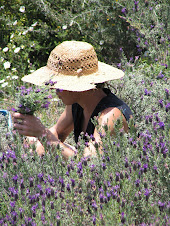Now I want to tell a different story.. about what is happening after collection.. you have seen the distillery, I suppose, maybe you have visited our
website and explored the basics of our distillations
here..
But now I have the advantage to show you details, as seen by a photographing visitor, Ina Hviding from Norway.. with her permission, ofcourse. Often, we do not see those things which seem such a natural part of our lives- do not imagine how it must be to be a total stranger, a newcomer to an experience which is so familiar to us..
And her pictures captured both the technical aspect, as well as the magic..
We had come to the distillery in the early morning, comminuted the bay laurel leaves, as pictured earlier this month in this blog, and filled the distillery...
Ina captured the beginning of the distillation, that what we call 'its running'.. the distillate, a mixture of water, hydrolate, and essential oil components, are distilling over. The liquid is initially filtered by a sieve in the funnel, and fills the 'florentine vase', the vase which separates the hydrolate from the essential oil continuously.. you can just see the separating device below the funnel here..

Now, in the next picture, you see the florentine to the left, the container holding the hydrolate on the right. As the essential oil is, in most cases, lighter than water or the hydrolate, it will float and accumulate on top in the florentine, whereas the hydrolate will be constantly drawn from the bottom...

So, during distillation, the hydrolate is flowing constantly into its receiving container, whereas the essential oil accumulates in the top part of the florentine. Note the top tap, closed now, whereas the bottom tap allows the flow of the hydrolate.. Enlarge the pictures for a better view...

Here we see the hydrolate flowing into the receiving container.. Laurus and rosemary hydrolate is our precious aqueous basis for shampoo...so a very much appreciated 'by-product'..
Then comes the magic moment- we are drawing the essential oil..now we have closed the tap for the flow of the hydrolate and opened the upper tap... by now it is dark, night...and the first oil is coming...

Here the oil is running into the final glas separator...

And then, the glas device fills, drop by drop.. I'll show you all the pictures here, because it was difficult to decide which one was the best.. and to me, they are all beautiful...



And here, in this last picture, you can see our final yield.. we have drawn some hydrolate, visible in the bottom of the glas separator in order to make sure that we got all the oil.. You can clearly see the separation, and we will drain the hydrolate below before filling the oil into

its glasbottle..

Work not over yet, the distillery has to be emptied for spent plantmaterial, cleaned thoroughly in order to be ready for the next distillation... tomorrow we'll collect Myrtus communis, myrtle leaves..Myrtle collection is a 'social' collection, as we need enough friends to come and collect the amount of plantmaterial we need to fill the distilleries in a single day... as myrtle has to be distilled fresh. So tomorrow morning we have an appointment....



















































